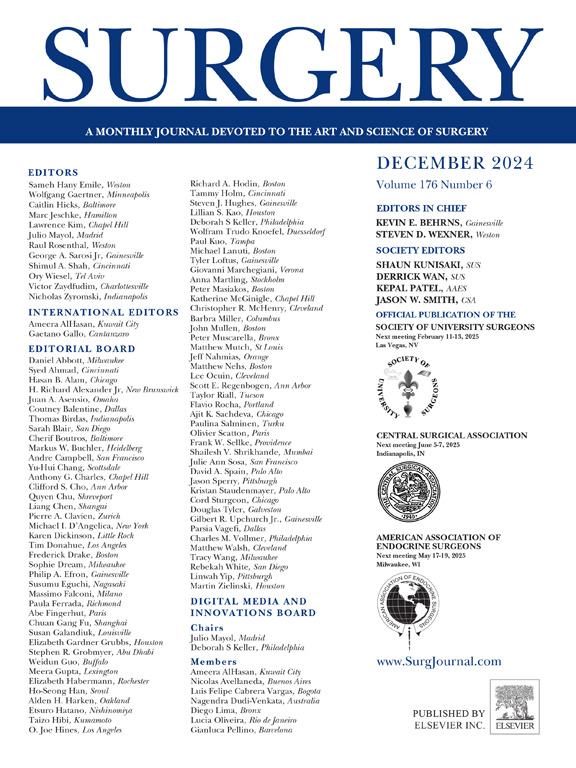Evaluation of interfacility transfer patterns among patients with emergency general surgery conditions
IF 2.7
2区 医学
Q1 SURGERY
引用次数: 0
Abstract
Background
Interfacility transfer for emergency general surgery is a key strategy for improving access to care. However, lower-intensity transfers are linked to increased costs, poor patient and family experience, and inefficient resource allocation. Clinical and health system characteristics associated with lower-intensity transfers among patients with emergency general surgery conditions remain unclear.
Methods
We performed a cohort study among adults with emergency general surgery conditions using claims data from Florida and California. Lower-intensity transfers were defined as admissions ≤3 days with discharge to home without procedural intervention. These were compared with greater-intensity transfers (admission >3 days, nonhome discharge, or procedural intervention), lower-intensity nontransfers, and higher-intensity nontransfers. We used multinomial logistic regression to identify patient and facility factors present on admission that were associated with lower-intensity transfer compared with other encounter types.
Results
Of 211,466 patients who underwent emergency general surgery, lower-intensity transfers encompassed 0.7% of encounters overall and 30% of transfers. Factors associated with lower-intensity transfer compared with nontransfer included Medicaid insurance, history of bariatric surgery, patients presenting to a critical access hospital, patients with cholecystitis, and patients presenting with higher-complexity surgical disease. Patients presenting to hospitals with advanced gastroenterology and palliative care were less likely to undergo lower-intensity transfer (P < .05 for all).
Conclusion
Facility characteristics are associated with lower-intensity transfers among patients who undergo emergency general surgery and may be a future target for policy aimed at improving the efficiency and quality of regional emergency general surgery care. Understanding clinical and resource needs of patients who undergo emergency general surgery may facilitate the development of interventions to support emergency general surgery care in resource-limited settings and triage patients requiring high-complexity care to tertiary and quaternary facilities.

急诊普通外科病人医院间转诊模式的评估
背景急诊普外科的设施间转诊是改善获得护理机会的关键战略。然而,低强度转移与成本增加、患者和家庭经验不足以及资源分配效率低下有关。与急诊普外科患者之间低强度转移相关的临床和卫生系统特征尚不清楚。方法:我们使用来自佛罗里达州和加利福尼亚州的索赔数据,对急诊普通外科患者进行队列研究。低强度转移定义为入院≤3天,出院回家,无程序干预。将这些数据与高强度转移(入院3天,非家庭出院或程序性干预)、低强度非转移和高强度非转移进行比较。我们使用多项逻辑回归来确定入院时存在的与其他遭遇类型相比与低强度转移相关的患者和设施因素。结果在接受急诊普通外科手术的211,466例患者中,低强度转移占总就诊人数的0.7%,占转移人数的30%。与非转移相比,与低强度转移相关的因素包括医疗补助保险、减肥手术史、在关键医院就诊的患者、胆囊炎患者和出现高复杂性外科疾病的患者。到医院接受高级胃肠病学和姑息治疗的患者不太可能接受低强度转移(P <;0.05)。结论设施特征与急诊普外科患者的低强度转移有关,可能是未来旨在提高地区急诊普外科护理效率和质量的政策目标。了解接受紧急普外科手术的患者的临床和资源需求可以促进干预措施的发展,以支持在资源有限的环境中进行紧急普外科护理,并将需要高复杂性护理的患者分流到三级和四级设施。
本文章由计算机程序翻译,如有差异,请以英文原文为准。
求助全文
约1分钟内获得全文
求助全文
来源期刊

Surgery
医学-外科
CiteScore
5.40
自引率
5.30%
发文量
687
审稿时长
64 days
期刊介绍:
For 66 years, Surgery has published practical, authoritative information about procedures, clinical advances, and major trends shaping general surgery. Each issue features original scientific contributions and clinical reports. Peer-reviewed articles cover topics in oncology, trauma, gastrointestinal, vascular, and transplantation surgery. The journal also publishes papers from the meetings of its sponsoring societies, the Society of University Surgeons, the Central Surgical Association, and the American Association of Endocrine Surgeons.
 求助内容:
求助内容: 应助结果提醒方式:
应助结果提醒方式:


